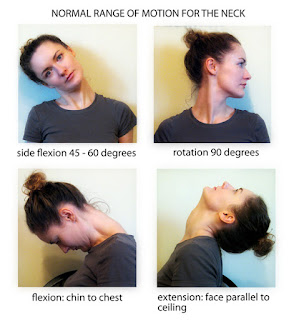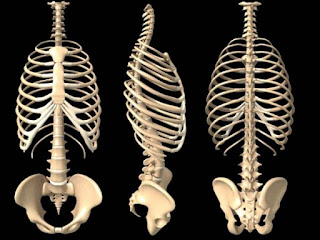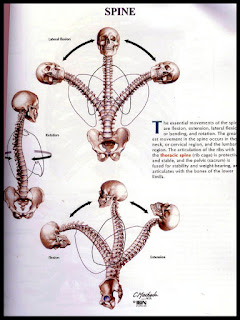together to give our bodies a strong support structure, as well as a wide range
of flexibility. Because of this, we're able to do a lot of crazy things in our
animations that really push our rigs to the limits without it looking odd.
That said, the spine and neck joints don't have an infinite range of motion,
so it is possible to "break" our characters and pose them in ways that just
don't feel natural.
These tips will talk about just how much the human neck and spine are able to
bend, and what kind of limitations they have. As animators though, we're allowed
a certain freedom with this, but it's always good to know the rules before you
break them.
Range of Movement in the Human Neck
The neck is an interesting part of the human body. It's the uppermost portion of
the spine, sitting above the ribcage, and connects our heads to our bodies in a
way that allows us to have a huge range of motion to be able to see and observe
our surroundings with ease.
Our necks have two main pivot points; one at the base of the neck on the shoulders
where the upper spine (neck) bends from, and another at the top of the neck where
the head sits. The pivot point on the shoulders is pretty well anchored into the
top of the ribcage, and as such is fairly limited in its movements. It can rotate
forwards and backwards (Rx) with a pretty wide range of motion, and that's about
it. The neck can rotate left to right (Rz) slightly, but it's very slight and usually
only bends that way when the rest of your spine is bending with it. And as
for twisting to look from side to side (Ry), that only happens in the head joint
since the base of your neck is anchored into your ribcage. You can test all of
this yourself by simply placing your hand on the back or side of your neck and
rotating your head and neck in one axis at a time while keeping your body still.

Now as for the upper joint in the neck that connects the head to the spine, it
has a much wider range of movement as it sits at the top of our flexible spine.
Your head can rotate in all directions and in multiple directions simultaneously
without any real difficulty. That said though, there are a few limitations. For
example, you can't turn your head around 180 degrees. The spine, as well as the
muscles and tendons in your neck just wouldn't allow it. As a rough guide, if
you were to face straight ahead, you would be able to rotate your head within 90
degrees left, right, up and down without putting too much of a strain on your
neck. However rotating your head from side to side (Rz) is a bit more restricted,
only about 45-60 degrees.
And that's about it for the neck. Let's move on down to the rest of the vertebrae!
Range of Movement in the Human Torso
Moving down, we arrive at the spine and torso. The torso, also known as the chest,
or ribcage, is a large solid mass made up of ribs, collar bones, and a sternum, all
meant to support our body and protect our vital organs. The spine itself is much
thicker here than it was in the neck, but this doesn't stop it from being any less
flexible.
Unlike the neck, the spine has only one main area of articulation; the lower back.
You might be thinking "Wait a minute. Isn't he spine is flexible throughout, not
just in the lower back?" And the answer is yes, the spine by itself would be, but
the torso is anchored to the upper two thirds of the spine, which keeps it from
bending or articulating, as you can see in the image below. However, as animators
we can get a way with a fair bit of upper spine rotation to get good poses and
lines of action running through our characters.

The range of movement in the lower spine is pretty large. It can rotate around in
any direction without much difficulty. Like the lower neck, The forward and back
rotation (Rx) of the spine are the most flexible, though the side to side (Rz) has
more flexibility. And unlike the neck, the lower spine can also twist (Ry) fairly
well.
However, unless you're very flexible, or a contortionist, your spine won't be rotating
drastically. Most of the bending and twisting actions our bodies do comes from the
hips and our backs are simply complimenting it to add that extra reach or twist.
And in general, if you bend in one direction, your spine and lower neck pivot will
bend uniformly in that direction, giving a nice curve. The upper neck pivot is
exempt from this because it isn't part of the spinal column, but sits above it.

So now that we have a better idea of how the spine and neck work, we can go
ahead and start both applying and breaking the rules a bit to get strong, solid
poses in our work. By knowing that the spine doesn't have an infinite range of
motion and must bend uniformly throughout the spinal column, we can keep the
back from "breaking" in our shots. But we can also do things like rotate the
upper torso, despite it being naturally rigid, to give our poses more fluidity
and flow in certain actions.
Thank you for taking the time to read my post. I hope it's been helpful,
and as always, if you have any comments, questions or suggestions, you're
more than welcome to write a comment or send either Beau or me a message
on AM.

Wow. You guys have got your own school going on over here. Nice stuff!
ReplyDeleteGuys Awesome post!
ReplyDeleteI loved the Blog Also , Great work.
Thanks, Cam!
ReplyDeleteThanks, very informative!
ReplyDeleteHello it was really interesting and helpfull tips to be in mind! thanks a lot!!
ReplyDeleteuju! Gracias! this one is very useful
ReplyDelete